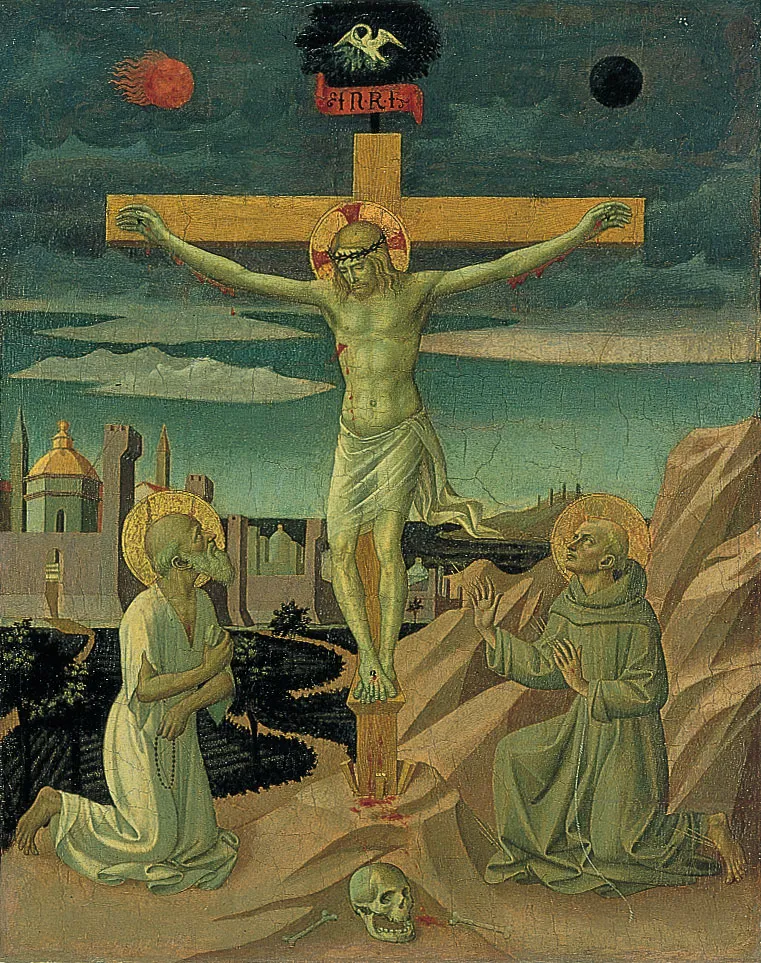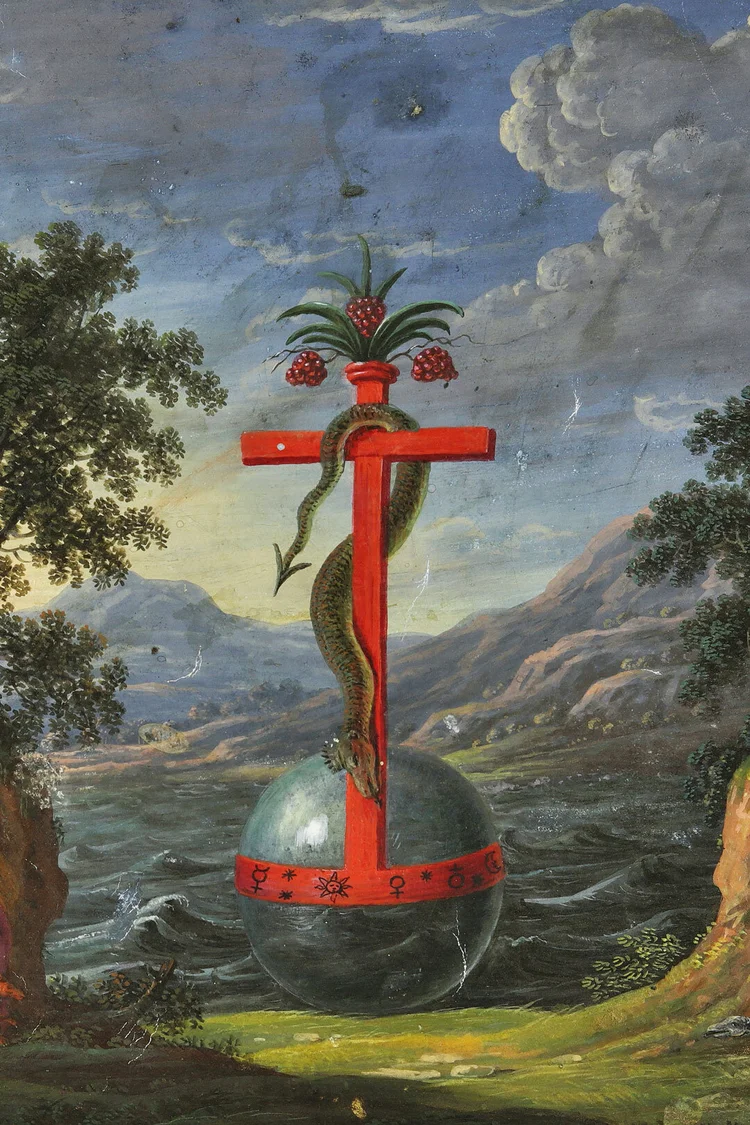The image of the serpent runs through every current of mystical tradition. It coils around the Tree of Knowledge in Genesis; it burns in the deserts of Israel as the bronze figure that heals those who gaze upon it; it curls at the base of the spine in the secret lore of yoga; it climbs the caduceus of Hermes, twin serpents circling a staff crowned with wings.
When we speak of the serpent, we speak of the path from ignorance to vision, from matter to Spirit and from fall to restoration. The serpent seduces, wounds and heals. It gives knowledge of good and evil; it awakens the duality of the human heart. “Your eyes shall be opened, and you shall be as gods, knowing good and evil” says the voice in Genesis 3:5. From that moment the innocence of paradise vanishes and consciousness is born. The serpent is the herald of gnosis.
I. The Ancient Coil of Kundalini
In the Sanskrit writings of the yogic schools the serpent appears as Kundalini, the power asleep at the base of the spine. She is described as coiled three and a half times, guarding the gate of freedom. When aroused, she rises through the subtle centres of the body, known as chakras, purifying and burning, until she pierces the crown of the head. The Yoga-Kundalini Upanishad speaks of this power as the very energy of liberation; the union of the finite soul with the infinite. The ascent is not gentle; it is fire. Tremors, visions and purifications accompany the journey, since the serpent does not rise without shaking the vessel.
The image of the serpent rising through the body is not foreign to the West. It mirrors the mystical ascent through the four worlds of the Kabbalah, from Assiah to Yetzirah, from Yetzirah to Briah, and finally into Atziluth. Each world is a station of refinement; each passage requires stripping away illusions. In both traditions the serpent is the energy of the return; the hidden flame that pulls the soul upward.
II. The Serpent in Scripture and Gnosis
The serpent of Eden is the bearer of knowledge. The voice says to the woman that eating the fruit will not bring death but vision. Genesis 3:7 continues: “And the eyes of them both were opened, and they knew that they were naked.” Knowledge reveals difference; it gives awareness of light and shadow. In the canonical reading this act is disobedience and fall. But, in the current of Gnosis, the serpent is seen as the envoy of Sophia, descending to awaken the clay figures shaped by the blind demiurge. In the Apocryphon of John, the creator proclaims “I am a jealous god and there is none beside me,” and the voice of higher wisdom reveals that this is the mark of ignorance. The serpent then is not the enemy of humanity, but the awakener.
This dual image is repeated in the desert. Numbers 21:9 tells how Moses lifted the bronze serpent upon a pole so that those bitten by fiery serpents may look upon it and live. The very image of the wound becomes the medicine. Centuries later, the Gospel of John 3:14 places this image upon Christ himself: “As Moses lifted up the serpent in the wilderness, even so must the Son of man be lifted up.” The serpent becomes Christic, a figure of elevation and healing. It is the sign of the fall and the sign of redemption.
In the esoteric commentaries, the serpent is also tied to the Shekinah, the indwelling presence of the Divine. Like Kundalini, Shekinah dwells in exile, at the base, awaiting union with the Holy One. Her rise is the restoration of the world. To embrace the serpent is to embrace wisdom; to embrace Sophia fallen into matter and to lift her back to the Pleroma.
III. The Ascent of Fire and the Cross of Flesh
The ascent of the serpent is always an ordeal. The fire that climbs the spine is the same fire that burned the lips of Isaiah with the coal from the altar. It is the fire that descends upon the disciples at Pentecost, tongues of flame resting upon their heads. Acts 2:3 speaks of “cloven tongues like fire, and it sat upon each of them.” The upward surge is Pentecostal, Kabbalistic, Hermetic. It is the Logos made flesh and burning within flesh.
In the hidden sefirah of Da’at, which means knowledge, the serpent reveals its deepest face. Knowledge in Hebrew is union, the intimate act of becoming one, as Genesis says of Adam knowing Eve. It is a knowledge that wounds and consumes, for to know is to lose innocence and to enter the tragedy of vision. Da’at is not a stable sefirah; it is suspended, appearing only when ascent begins, bridging the Son in Tifereth and the Mother in Binah. The serpent of Eden, who whispered “You shall be as Elohim,” is the same guardian of this hidden gate, opening the veil of consciousness and casting the soul out of the paradise of ignorance.
In the Zohar, the serpent is bound to the Nachash and at once to the figure of the hidden Messiah; fallen but carrying the fire of return. When the serpent rises through the spine, like Kundalini, like Shekinah, like the tongues of Pentecost, Da’at is reawakened in the body and the inner tree is made temple. This is why the serpent is said to rest in the bone called Sacrum, the sacred foundation of the column. The Latin name remembers the body as altar, and even its initial S coils like the serpent itself. In the words Spiritus Sanctus – Holy Spirit – the double S is the double serpent rising, a cipher of the holy ascent through flesh into vision.
In Christian symbolism, the ascent is traced upon the cross. The column of the body is stretched; the crown is pierced with thorns. The serpent exalted in the wilderness becomes Christ exalted on Golgotha. To raise the serpent is to raise the Son of Man. To accept the bite of knowledge is to accept the wound of the cross, since vision always carries pain. But from that pain flows healing, as from the bronze serpent flowed life.

In the caduceus of Hermes the two serpents ascend in union, balancing opposites, meeting at the winged crown. This is the same path of fire in the yogic texts, where Ida and Pingala coil around Sushumna and rise to the crown. The same truth repeats: the ascent of the serpent reconciles division. Good and evil, male and female, matter and spirit are bound and lifted into unity.
The foundation of this symbol is ancient, scriptural and experiential. It is written in the Upanishads, in the Torah, in the Gospel, and in the very structure of the human body. The serpent is knowledge, wisdom, fire, Sophia, Shekinah, Logos. To awaken it is to walk the razor of gnosis, to endure the cross of consciousness, and to see the world as wound and remedy at once.
Κύριε ελέησον
